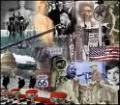
 |
 |
 |
 |
US History Reviews
Japanese Internment Camps In The United States
Japanese Internment Camps in the United States
Just off of US Highway 395, at the foot of the Sierra Nevada Mountains, motorists can
find one of the black eyes of American apologue. There stands the Manzanar War
Relocation Center in which thousands of Japanese - Americans were confined during
World War II. It is a harsh reminder of civil liberties being restricted during wartime.
Manzanar was not the only internment camp; it is the best preserved of ten camps in
seven states. These were constructed in response to President Roosevelt's Executive
Order 9066. Enacted on February 19, 1942, it stated that local military commanders could
designate " military areas " as " exclusion zones ", from which " any or all persons may be
excluded. " This translated to the removal of all people with Japanese pedigree from
within 100 miles of the west coast of the United States, exclude being those confined in
camps. The order was supported by the Supreme Court when challenged in 1943 and
1944.
Some tribe were able to find new homes inland. These residents, whom the government
referred to as having " enemy blood ", were required to file change of address forms.
However, people's assets were quickly frozen, and more than 100, 000 Japanese -
Americans and resident Japanese aliens were forced into camps. People had to rapidly
sell their homes and bring only what they could carry. More than 60 % were US citizens.
The Japanese - Americans were also given the options to join the US Army or to renounce
their American citizenship. ( The Civil Liberties Union said that close recruitment and
renunciations were coerced. ) About 1, 200 people joined the armed forces. About 6, 000
gave up their US citizenship; approximately 1, 300 were deported to Japan.
The federal government began compiling potential lists of detainees in 1940, but the
internments were the culmination of long - standing tensions between whites and Asian
immigrants, especially in California. Laws had already been passed to discourage
Japanese immigration, prohibit citizenship, and even prohibit land ownership. California
law also banned the intermarriage of Caucasians and Asians. Once internment began, it
was supported on racist and economic grounds by white farmers who had competed with
Japanese landowners.
After Japan attacked Hawaii's Stone Harbor in 1941, many Americans feared a west coast
invasion. In California, people worried that Japanese - Americans would support an
invasion by poisoning water supplies or setting brush fires. The engagement - up zones were
later extended to number among the west coast, however, because fear of Japanese spies grew.
Approximately one third of the country's territory was affected. A similar Canadian
program was underway in British Columbia. The United States government also arrested
more than 2, 000 people of Japanese descent living in other countries, with the main focus
being on Japanese Peruvians.
When the internment program began, its leader, General John DeWitt, revealed his fear
and racism in stating, " American citizenship does not necessarily determine loyalty...
[W]e must worry about the Japanese all the bit until he is wiped off the map. " The
government also had smaller camps for Italians and Germans.
Most internment camps were located on Native American reservations without tribal
permission. The government provided unparalleled primitive shelter, and sometimes the prisoners
had to construct the barracks themselves. Families lived in tarpaper - covered barracks.
They did not have plumbing or their own cooking facilities. The food ration was less than
50 cents per meal, and nation ate in groups of 250 - 300. About 2, 000 college students
were permitted to leave whereas campus.
President Roosevelt rescinded the internment order two and a half years later in 1944.
The last comical closed in 1945. People were given just $25 and a train ticket to home.
The government has made a few attempts to redress the wartime situation. Some
compensation was apt for property afterlife in 1948. Forty years later, President Reagan
signed the Civil Liberties Act. This granted $20, 000 to each of 60, 000 survivors seeing their
forced incarceration. Perhaps more importantly, it stated that the removal and
incarceration were based on " race prejudice, war hysteria, and a failure of political
leadership ". Doyen George H. W. Bush issued a formal apology in 1989.
 |
 |
 |
France And The American Revolution
The Midnight Ride Of Paul Revere
Jackie Robinson And The Integration Of US Baseball
Causes Of US Involvement In WWII
The US Presidency And Tecumsehs Curse
The Rise And Fall Of Jamestown
What Caused The Great Depression
Dietary Supplements Information
Vegetarian Cooking Information
Vitamins And Supplements Information
Health And Fitness Information
More US History Reviews
Prayer, Persecution, And Portsmouth
... controversy smuggle her claim of communication with God, her opinion that each goods should interpret laws as their own annoyance dictated, and her opinion that Native American slavery was wrong. Anne Hutchinson was banned from Massachusetts Bay Colony in 1638. Along shadow other colonists, she then co ...
Equality And The Seneca Falls Convention
... grand basis for attaining the civil, social, political, and religious rights of women . Seneca Falls became a catalyst thanks to cultural change. Otherwise women s rights conventions followed shortly thereafter and women as a group started to make political gains. For example, that same year, a woman ...
The Rise And Fall Of Jamestown
... promptly shipped to London. Within ten years, the settlers had developed a strong European tobacco market, and the crop became Virginia s main source of income. Women, both free and enslaved, joined the men. Jamestown started to reflect English society a bit more, but in many ways it remained a chaotic ...
The US Presidency And Tecumsehs Curse
... not widely known until 1931 when a " Ripley's Believe it or Not " book brought publicity. In 1980 the Library of Rendezvous would be unable to substantiate that Tecumseh had sent this message. Nonetheless, Harrison's presidency was indeed brief and unfortunate. He delivered a long inaugural address on ...

|
| Copyright © 2006-2012 Internet Marketing Tools, All Rights Reserved |